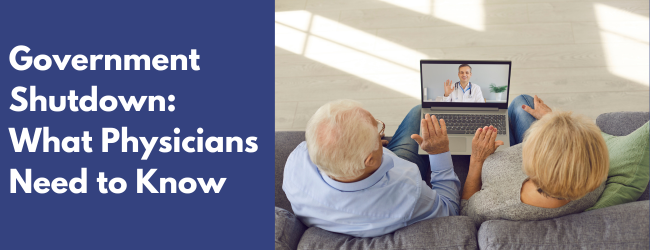Sharing on behalf of John Whyte, MD, MPH, American Medical Association, CEO and Executive Vice President.
According to the Centers for Medicare & Medicaid Services (CMS) contingency plan, during a lapse in funding, the Medicare Program will continue. CMS has sufficient funding for Medicaid to fund the first quarter of FY 2026, based on the advance appropriation provided for in the Full-Year Continuing Appropriations and Extensions Act, 2025. CMS is maintaining the staff necessary to make payments to eligible states for the Children’s Health Insurance Program (CHIP). CMS is also continuing Federal Marketplace activities, such as eligibility verification, using Federal Marketplace user fee carryover. Other non-discretionary activities including Health Care Fraud and Abuse Control (HCFAC) and Center for Medicare & Medicaid Innovation (CMMI) activities are also continuing.
During the shutdown, CMS expects slowdowns or suspensions of the following agency activities: (1) health care facility survey and certification, (2) policy development and rulemaking, (3) contract oversight, (4) outreach and education, and (5) beneficiary casework. CMS retains 53% of its staff to continue essential operations, while 47% of agency staff are being furloughed (i.e., temporarily on unpaid leave).
As discussed in our note last Friday, physicians who provide telehealth services to Medicare patients should be aware that the Medicare telehealth flexibilities lapsed for care to all patients except those being treated for mental health or substance use disorders. This means that telehealth services are limited to rural areas as they were before the COVID public health emergency and that patients cannot receive telehealth services in their homes. Note, however, physicians in certain Medicare Shared Savings Program accountable care organizations (ACOs) can continue to provide and be paid for telehealth services. In addition, the ability to provide audio-only services to Medicare patients lapsed, as did the Acute Hospital Care at Home program.
Additionally, funding extensions for community health centers, the National Health Service Corps, and teaching health centers that operate graduate medical education (GME) programs expired on Sept. 30, 2025. The 1.0 work geographic practice cost index (GPCI) floor extension expires on Oct. 1, 2025. Additional programs that were funded through the end of the previous continuing resolution and have now lapsed include: special diabetes programs; public health emergency authorities (e.g., Public Health Emergency Fund); increased inpatient hospital payment adjustment for certain low-volume hospitals; Medicare-Dependent Hospital (MDH) program; quality measure endorsement, input, and selection; and outreach and assistance for low-income programs (e.g., area agencies on aging).
Due to the expiration of these legislative payment provisions, Medicare Administrative Contractors (MACs) have been instructed to implement a temporary claims hold of 10 business days. It should have minimal impact on physicians due to the 14-day payment floor. Physicians may continue to submit claims during this period, but payment will not be released until the hold is lifted. For the latest information, physicians should monitor their MAC’s website and this CMS webpage.
In the past, Congress generally has restored lapsed policies back to the effective date of the shutdown. During the shutdown the AMA is monitoring any potential delays in Medicare claims processing or other Medicare payment problems that could result from federal staffing reductions at CMS, including during the shutdown. Physicians and medical practice staff who experience Medicare payment delays or other obstacles that could be tied to reduced staffing levels at the agency or its Medicare Administrative Contractors (MACs) are asked to inform AMA advocacy staff of these problems by emailing ama.advocacy@ama-assn.org and including the subject heading “Medicare Payment Delay.”
The AMA is in touch with senior CMS officials. We will work with them to resolve issues and circulate additional information as the situation develops.






